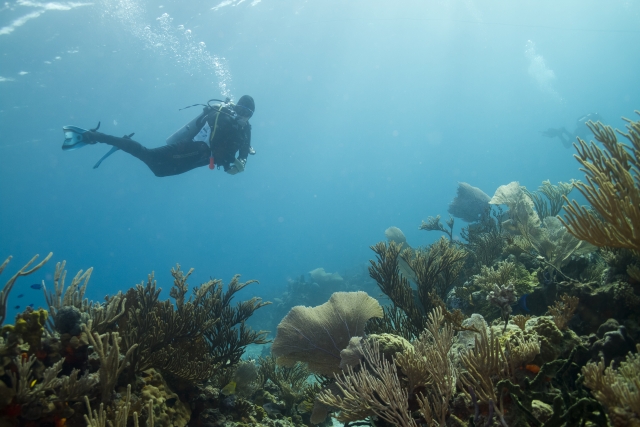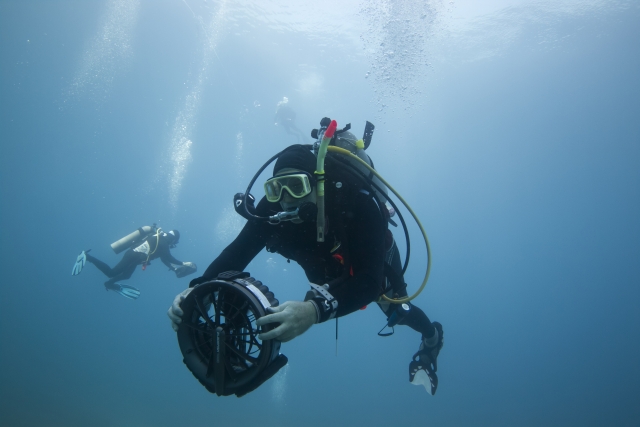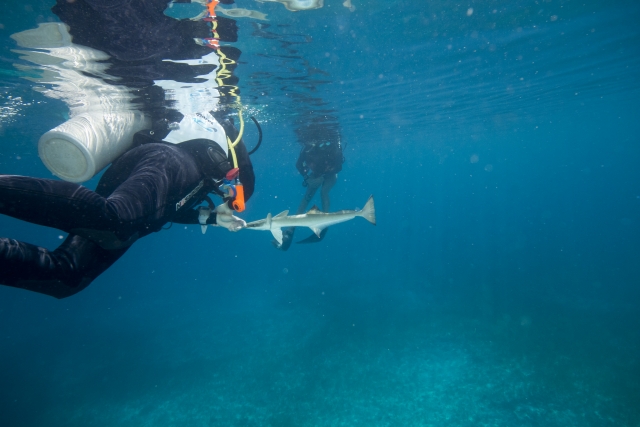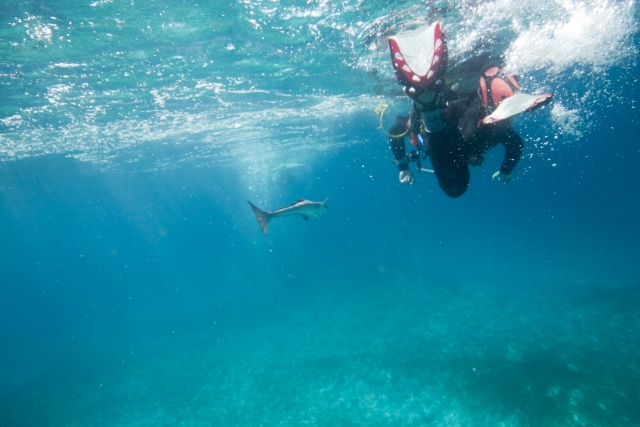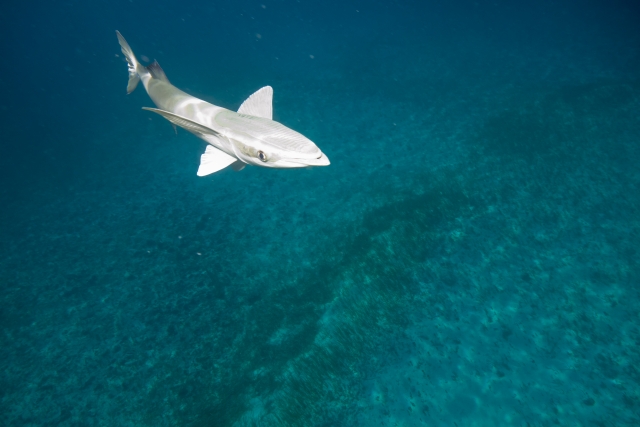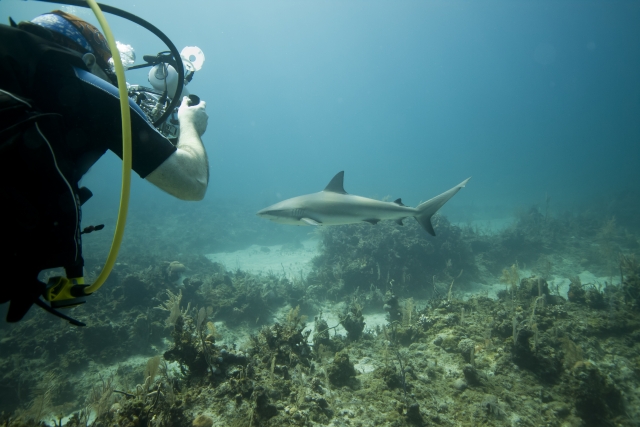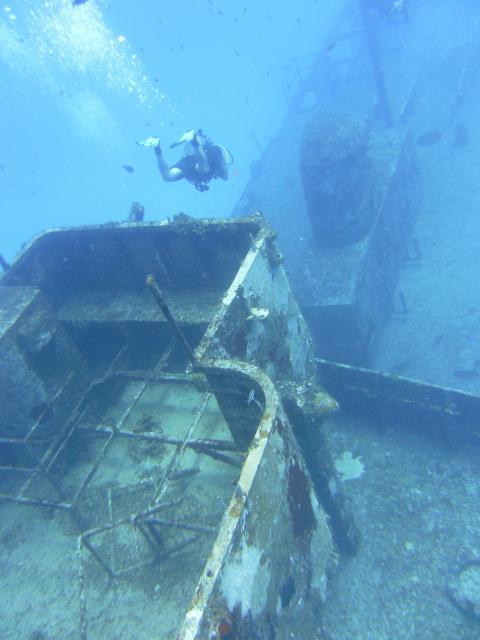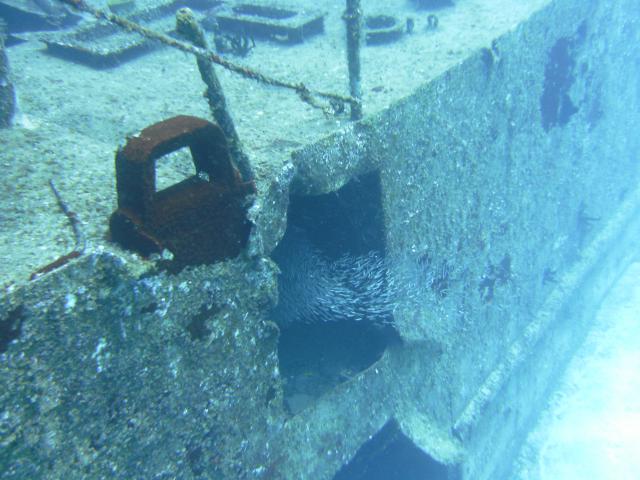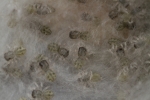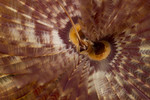divers
Divehards International: Instructors, Divemasters, Friends!
ktuli — Sat, 11/01/2014 - 16:49
So I know I usually just talk about and share photos of the critters we see on our dives, but let's take a few minutes and talk about Mike and Brigette Nadler - our dive instructors, divemasters, trip planners, friends!
We started our scuba class at the old CCAC North Shore campus pool in early 2011. To be honest, I had a really rough time starting out with scuba... my brain just did not want to accept the idea of breathing underwater, I was not a strong swimmer, and I just all around had a difficult time getting started. Both Brigette and Mike worked with me to help me to get comfortable and figure out what was being a sticking point for me, and I did indeed eventually finish the course. We then got our open water certifications in Summersville, WV that summer.
Since then we've been on six different trips with them and they continue to help us with instruction and guidance. Both of them are constantly paying attention to their divers and are able to help improve your diving by providing insight and suggestions on things to improve. For me specifically, this has ranged from simple things like noticing that I easily get cold in the water and recommending additional layers, to more subtle things like that I do not hover level in the water and suggesting I use trim weights to help keep myself more level (which reduces the effort it takes to move through the water and thus reduce air consumption). The cool part about it though is that they never make it feel like they're lecturing you or belittling your diving abilities - all of their observations and how they present them to you are done in a constructive and helpful manner that you almost don't even notice that they're still giving you additional diving instruction well after you've "completed" their scuba class.
It seems like every trip I end up with at least one photo of Brigette underwater. I think this is probably because when we're diving, Brig seems to be almost one with the water and just fits into the landscape. I think almost all of those photos I have of her are of the reef with Brig just floating nearby (and this one is no different). Brigette's air consumption (or lack thereof) is pretty well legendary within our group (actually, this last trip we literally witnessed her complete two hour long dives on a single tank of air!). I think that air consumption is due in part to how Brigette seems to dive - effortless, smooth, streamlined... completely calm. That's exactly how Brig's instructing style works too.
Mike is probably the polar opposite... in a good way of course. With who knows how many thousands of dives in his log book, Mike is still excited to hit the water every single time. That excitement is evident on land too as Mike is boisterous and constantly having fun. As he puts it, he is an "equal opportunity antagonizer" which translates to the fact that he is constantly making sure that everyone is involved in the group and no one gets overlooked. Back in the water, Mike is constantly zipping around, and I think on any given dive he visits with each and every diver at least once. Not in the sense that he is taking roll-call and checking on everyone, but more that he is excited to interact with everyone and see everything that is going on. But that whole time, he definitely is paying attention to each and every one of his divers. I think it might be because of that zipping around that I didn't seem to have many photos of Mike, but this trip I did manage to several including this pretty cool one...
Honestly, I think Brig looks a little awkward with that underwater vehicle/scooter, but that's probably just a case of bad timing on my part.
Together, Mike and Brigette make the perfect combination. As dive instructors, they are incredibly thorough and patient - making sure that their students understand the material and are completely prepared to dive. As divemasters, they continue their instruction, constantly making sure their divers are learning and having a safe experience underwater. As trip planners, they constantly try to find new experiences for the group, exploring new places, and returning to old tried-and-true favorites.
If you're looking to get into scuba diving, there isn't a better set of people you'd want leading the way for you!
- Bill
Aqua Cat: Remora Visit
ktuli — Thu, 10/30/2014 - 16:38
Another critter that we received a number of visits from on this trip were remoras.
For those who are curious, a remora is a type of fish with a suction-cup like disc on its head that it uses to attach itself to larger animals such as sharks, turtles, etc. It then uses the larger animal to hitch a ride and to also get free meals in the form of scraps. As such, you don't normally see a free-swimming remora without its host animal. Some species grow to about 3 feet long, but usually they seem to be in the 12-18 inch range.
Well, for whatever reason, we had multiple dives where we would see free-swimming remoras without a host animal. On this early dive, the remora was quite interested in our group, and looked like it was ready to latch right onto one of our divers...
First it gave Brigette a bit of a start...
Then it thought about latching onto her scuba fin...
Which garnered enough attention that it quickly became a subject for many of the divers carrying cameras...
Then I think it considered latching onto my leg...
And I think it gave Mike a good chase! (ok, I think this is a coincidence, but it certainly looks like Mike is swimming like crazy to try and get away from it, no?)
It also stopped by to say hi and get petted by Anya...
And finally came in for its close-up photo.
Unfortunately, I was still shooting with the Sigma 10-20mm lens at this point, so I had to be really close to get photos that worked (otherwise everything looked tiny in the frame). Luckily, only a couple more dives before I started figuring things out and getting more consistent results.
Stay tuned!
- Bill
Aqua Cat: Popular Photo Subject
ktuli — Tue, 10/28/2014 - 20:55
Well, sharks - Caribbean Reef Sharks to be precise - were probably the marquee critter on this trip, so we might as well get right into them now.
The other diver in this shot is our friend Jim (or "Ferris"), and as the two of us lined up to take shots of this shark, I thought it might be cool to show another diver in the frame. It also helped that I was shooting with the Sigma 10-20mm super-wide-angle lens to let me get plenty of stuff in the frame. What that lens didn't help was maintaining size perspective as it compressed a wide area into the frame making the shark (which is probably about 15 feet away from us) look much smaller than it was (probably about 6-8 feet long).
Technical Data: Canon EOS 7D, Sigma 10-20mm f/4-5.6 EX DC HSM AF at 14mm, 1/120 sec at f/5. ISO 400. Ikelite Housing and Port with dual Ikelite DS 161 Strobes in eTTL mode. Raw conversion Adobe Camera Raw.
There's plenty more to come, so stay tuned...
- Bill
Cozumel 2010: C-53 Wreck Dive
ktuli — Sun, 06/27/2010 - 10:11
This year we dove the C-53 Felipe Xicotenantl wreck in Cozumel.
This was Anya's and my first wreck dive ever. And was it ever fun!
The C-53 is a 184 ft long Mexican Navy Minesweeper. Sunk in June of 2000, it is just starting to get a good amount of coral growth on the hull of the ship. Since the vessel was sunk intentionally for divers, sections of its hull were removed to allow for easier entry into the wreck, and guide lines were installed to show the safest route through the dive. The wreck sits on a sandy bottom at about 80 feet with the main deck only about 60 feet from the surface - you can actually make out the general shape of the wreck from the boat since the water in Cozumel is so clear. With a mask and snorkel, you can view the wreck plainly from the surface (which I did after I used all of my air and waited for the rest of the group to get back on our dive boat.
Part of our group did the full tour of the wreck, following the guide lines and exploring multiple decks of the ship from the inside. Their path took them from the stern of the ship along the various decks and eventually emerging from an opening near the bow. I think they then re-entered from one of the side openings and explored further, but I lost track of them.
Anya and I chose to explore the outside of the ship. We circled the entire wreck, stopping to inspect the propellers (which were the hang-outs for some fairly large and extremely toothy dog snappers). We then followed our dive master Markos on a quick swim-thru of the second deck at mid-ship. At that point in the ship was a fairly large school of silverside sardines (these are actually common in the pet trade as frozen foods). These little fish (which you can see the edge of the school protruding from the opening we entered the boat from) would flee and return around you as you swam through the ship. As I did my swim-thru, I stopped about halfway through, and noticed that the density of the fish both in-front and behind me actually blocked the visibility to the entrance and exit. It was very fun to swim through the group of them.

This was really a fun dive, and it was a great experience to get a wreck dive under our belts. We had a visit from another sea turtle on this dive - in fact we had sea turtles on every dive I think - but I didn't get any good photos of this one. However, this happened to be one of the dives that the resort's videographer came with us, and she got a sequence of the boat from a unique angle with the turtle doing a fantastic swim-by at the exact right moment - I might strip out a still or two from the DVD, but we'll see.
Stop by again soon, as I'll be sharing some wildlife photos including one of a sea turtle we saw that was - no lie - the size of a small car!
- Bill
Cozumel 2010: Coralheads and Divers
ktuli — Fri, 06/25/2010 - 22:01
So I really like photos of coralheads with divers. There is something about the combination that I like - it might be the sense of scale, or just the visual presentation of the activity I've grown to enjoy - but I found myself looking for such opportunities on this year's dive trip to Cozumel.
If you haven't seen the inspirational shot from last year's trip, take a few minutes and go read the discussion of the photoshop adjustments I made to another coralhead and divers photo.
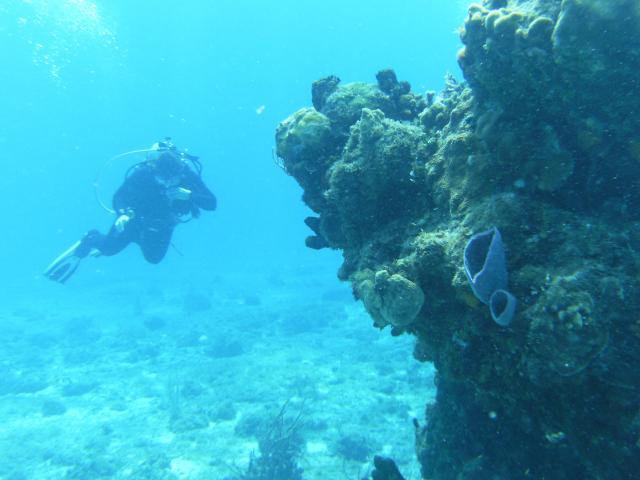
This one I snapped of Anya with this small coralhead in the foreground. I am not overly thrilled with this photo as I didn't like the posture I caught Anya in - she was adjusting some equipment or maybe just finishing up equalizing her ears. You need to get the air pressure inside your ears to match that outside, so as you dive you have to constantly be aware of it and equalize as needed. It becomes something you almost do without thinking or it can really hurt! Think about when you last flew in an airplane or drove to the top of a mountain - did your ears "pop"? That's basically the same thing but with water pressure pressing on your ears and you need to get it to balance on the inside. Anyway - it doesn't make for really great photograph material.
It isn't often that Anya is that far from me during a dive. We tend to be pretty conservative divers and stick pretty close. Plus, just like on our terrestrial photo excursions, Anya tends to be a fantastic spotter, so usually she's just ahead of me pointing out the cool thing to photograph next.
The other coralhead and diver photo is of one of our dive instructors - Brigette. She is the epitome of calm when diving. I am amazed to see a bubble trail coming from her in this photo actually, because many of us believe she doesn't breath at all while underwater (there are rumors of gills hiding somewhere). Brigette almost always gets back on the boat with the most air left in her tank of any of the divers in our group. I think both Anya and I strive to someday be as calm in the water as Brigette.
Anyway, I like this photo a bit more from a technical standpoint. The overall layout - especially with the vertical orientation - helps to provide a different perspective to things. The coralhead in the foreground helps to add to the perception of the size (though it does exaggerate the coralhead to be larger than it was). The placement of the coralhead falls nicely on one of the thirds, providing a nice balance to the photo and produces much less empty blue space than the previous photo.
What I don't like about the photo (aside from the blue color cast) is the lack of depth perception - the photo appears to be extremely flat. That might be fixable in photoshop. Unfortunately, the timing was slightly off here too as I left Brig's fins hidden behind the coralhead, which I feel leaves out a vital element of a photo of a diver. And of course, the color cast causes the coralhead to lose all of its beautiful color and diversity.
Ok - so I guess I could resist critiquing the photos after all... I just took a less formal approach to it. Be sure to stop back again soon as I have wreck photos, fish photos, and maybe some other little surprises in the hopper for additional posts from this trip.
- Bill
Poll: Foray into Photoshop
ktuli — Sat, 02/27/2010 - 19:28
Normally I hate modified photos. In particular, I hate modified photos when you can tell the photo has been modified.
One of the presents Anya got me for Christmas was a copy of Photoshop Elements. At first, I wasn't sure whether I would use it much.
With my recent venture into entering various competitions, I've found the need to use it a bit more.
We have some photos from our dive trip to Cozumel, and I love them as photos, but their color isn't necessarily spot on.
So I modified the following photo to see if I could make the colors closer to what I remembered them to be like. Take a look at the original and the modified version below, and vote for which one you like better.

Unmodified
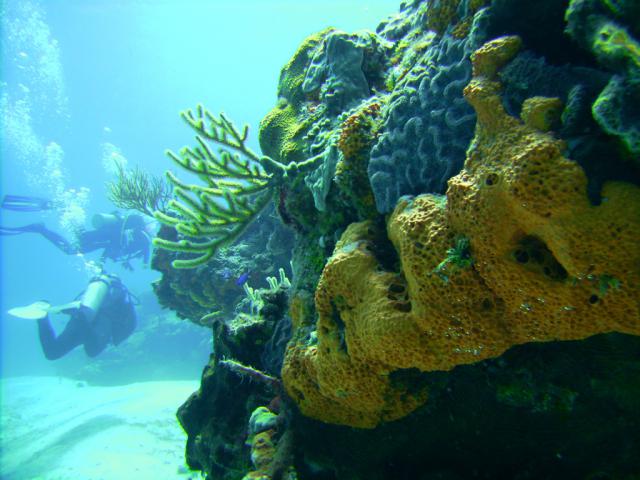
Modified
Unfortunately, I forget what exact changes I made (something I will try to be a bit better about recording in the future), but I know that I darkened the photo and adjust the contrast slightly. I also modified the colors slightly to remove a bit of the blue color cast that is typical of underwater photography.
The colors in underwater photography without a ton of flash is usually not accurate since the spectrum of light drops off the deeper you go. Did you know that? That is one of those things you don't really think about, but you learn when you get scuba certified.
Anyway - vote for which version of the photo you like better, and leave a comment to back up your vote.
- Bill


